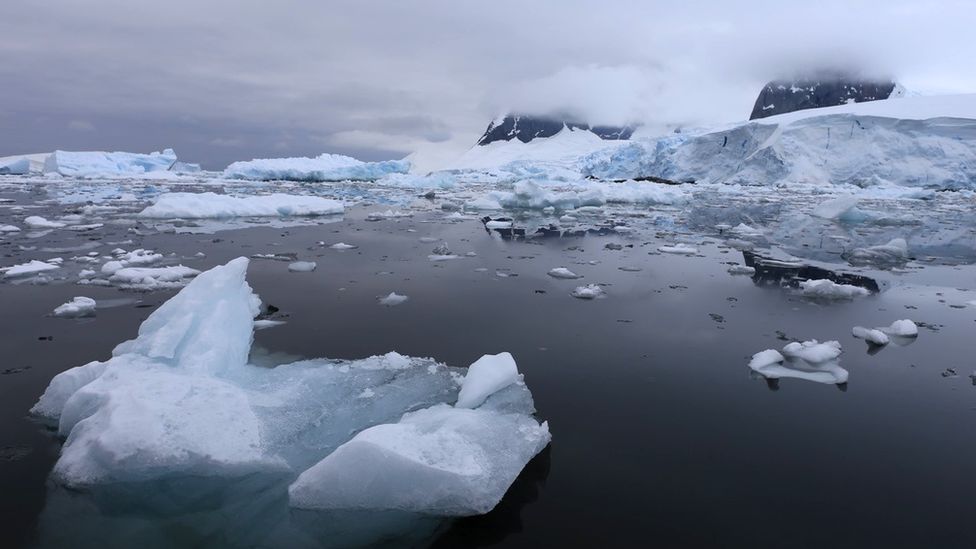Species from around the world that are “hitching a lift” on ships threaten Antarctica’s pristine marine ecosystem.
That is the conclusion of a study tracking research, fishing and tourist vessels that routinely visit the protected, otherwise isolated region.
It revealed that ships from 1,500 ports around the globe visit Antarctica.
“These ships travel all around the world,” explained lead researcher Arlie McCarthy from the University of Cambridge.
“It means that almost anywhere could be a potential source for invasive species.” Those non-native species, she explained, “can completely change an ecosystem”.
“They can create entirely new habitats that would make it harder for those amazing Antarctic animals to find their own place to live.”

The scientists say that more stringent measures are needed to ensure that ships do not bring species that could disrupt Antarctica’s fragile habitats.
The research team, from the British Antarctic Survey and the University of Cambridge, used satellite data and international shipping databases to work out the weight of Antarctic traffic – and the origin of those ships.
“What was really surprising was that they don’t just have one home port that they go back and forth to,” said Ms McCarthy.
Instead, the global movement of vessels links otherwise isolated parts of Antarctica to more than 1,500 ports all around the world.
Clinging on
Any marine species that can cling to the hull of the ship and survive the journey to Antarctica could pose an invasive threat.
Creatures, including mussels, barnacles, crabs and algae, are of particular concern, because they attach themselves to hulls, in a process termed “biofouling”.

Mussels, for example, can survive in polar waters and spread easily, threatening marine life on the seabed. Their water filtering alters the marine food chain and also the chemistry of the water around them.
“This is the last place in the world where we don’t have marine invasive species,” explained Ms McCarthy. “So we [still] have an opportunity to protect it.”
Professor David Aldridge from the University of Cambridge explained: “Antarctica’s native species have been isolated for the last 15-30 million years.”
This makes invasive species one of the biggest threats to its biodiversity. And, as Prof Lloyd Peck from the British Antarctic Survey added, “your chance of losing a species that is completely unique is much higher in the Antarctic”.
Tourist traffic
Tourism is regulated in the region; tourist ships have to follow biosecurity protocols. But this study revealed that tourism accounted for 67% of visits to Antarctic locations (followed by research, which accounted for 21% and fishing, 7%).

According to the International Association of Antarctic Tour Operators, the 2019/20 season saw more that 70,000 people visit the region. And while the industry has been disrupted by the pandemic, that number has been increasing steadily since the first few hundred visitors from Chile and Argentina arrived in the South Shetland Islands in the 1950s.
It is an increase, say researchers, that has other consequences.
Ms McCarthy told BBC News: “Anywhere these ships go, we see other kinds of human impact on the environment, whether that is accidental release of waste, pollution, collisions with wildlife or noise disturbance.”
Prof Peck said Antarctic tourism was both “positive and negative”. “They are a big part of the number of visits [to the continent] and therefore could bring [non-native species] in.
“But the tour operators are very interested in the environment and take a lot of security measures.”

More broadly, biosecurity measures to protect Antarctica – such as cleaning ships’ hulls – are currently focused on a small group of recognised Antarctic “gateway ports”.
But since this study revealed that many more ports around the world are linked to the region, the British Antarctic Survey is calling for “improved biosecurity protocols” and environmental protection measures to protect Antarctic waters. This means inspecting ship hulls with cameras and cleaning them more frequently.
Prof Peck said this was particularly important “as ocean temperatures continue to rise due to climate change”. He added: “we know something will arrive if we leave things as they are”.
Follow Victoria on Twitter


























